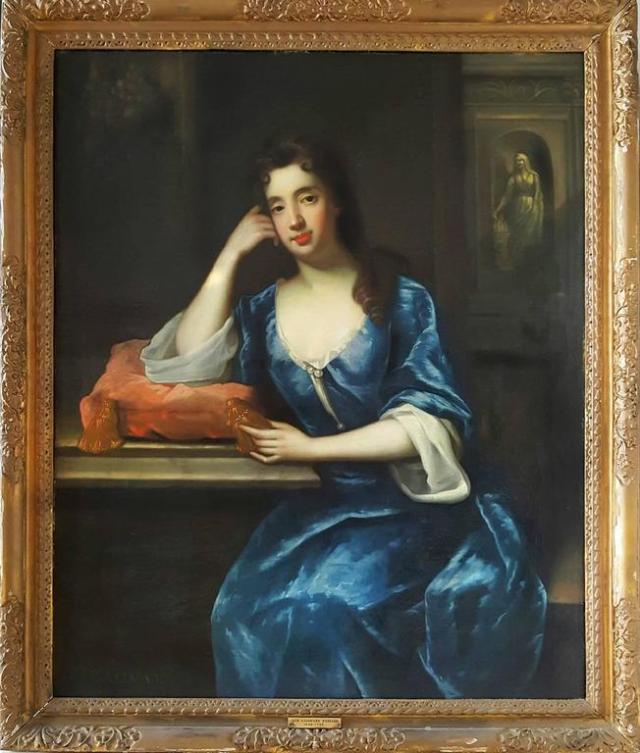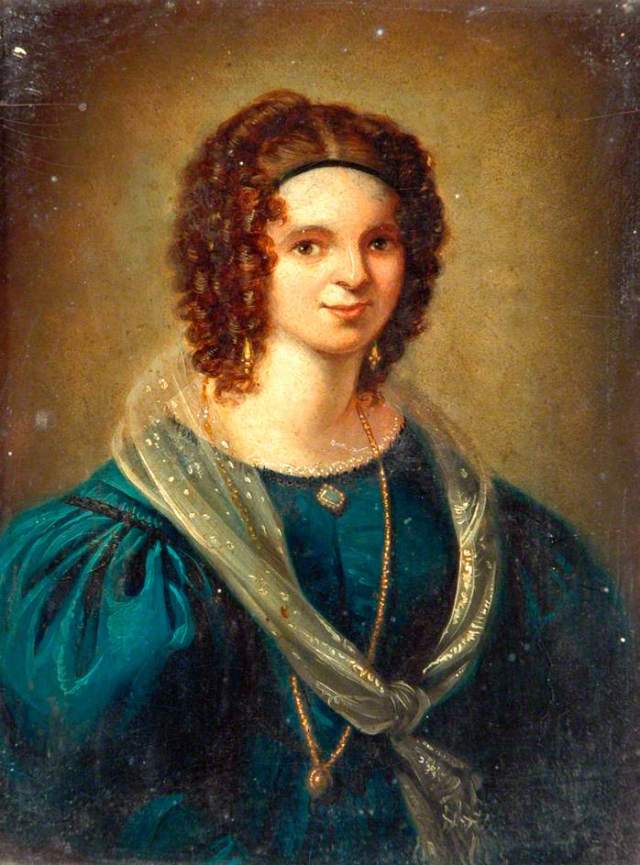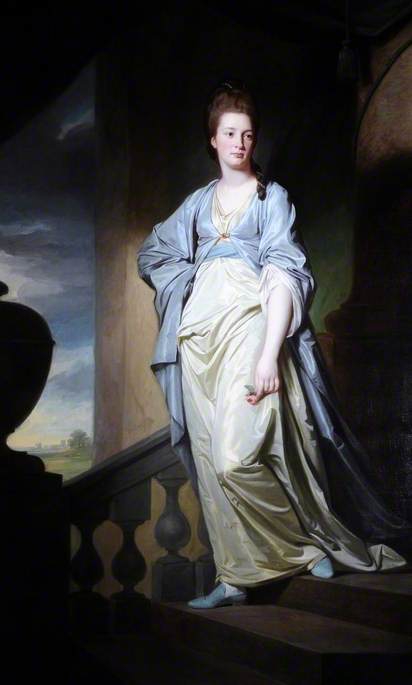No-one seems quite sure how the colour blue became associated with the feeling of sadness, some say its origins lay back in Greek mythology whilst others say it has links to the devil. Whatever the true origin, how could anyone possibly feel blue wearing these sumptuous gowns that we’re going to take a look at?

So many shades of blue exist, from the palest baby blue to darkest navy blue and everything in-between and the colour was clearly very popular during the Georgian era. Given the amazing array of paintings sadly I only have space to share few with you, but I do hope you enjoy them.

An interesting point worth noting about these paintings is that to create the impression of fabric required a very specific skill and it seems, not a skill that some of the most famous artists had, so they employed ‘drapery painters’ to paint the more intricate and detailed aspects of fabrics, to ensure that they looked as natural as possible. One of these, who was regarded as being amongst the best was Joseph Van Aken. Another was Peter Toms who was one of the founding members of the Royal Academy.
Mr James Peters was Kneller’s drapery painter so it seems highly likely that he painted this stunning blue dress.

I came across this description in The London Tradesman, of exactly what a drapery painter’s role was so thought you might find it interesting.
The drapery painter is but the lowest degree of a liberal painter; he is employed in dressing the figures, after the painter has finished the face, given the figure its proper attitude and drawn the outlines of the dress or drapery.
A portrait painter who is well employed, has not time to cloath his figures, and therefore employs a drapery painter to finish that part of the work.
This workman must have a tolerable notion of painting in general; but his chief skill consists in his knowledge of colours and the mixing of them, to produce proper shades; for the painter generally draws the outline and leave him to fill up the empty space with proper colours.
The drapery painters are generally employed in signpost drawing, and other sorts of painting that do not require a masterly hand: they have commonly but a dull genius and a mere mechanical head: however, those who are eminent in their way and in the employ of a noted master make very handsome bread; they may sometimes earn a guinea a day, and must be mere bunglers if they cannot make half a guinea.
Their education may be as low as you please; but as in all other branches that handle the pencil, they ought to be early acquainted with the use of it: the sooner they are bound apprentices the greater proficiency they may be expected to make. A sober disposition and a sound constitution are absolutely requisite.

And the final selection:




UPDATE
Following a great deal of discussion amongst readers, I thought I would add some of the earliest references to a few shades of blue that I have come across in the newspapers.
Navy Blue
Mr. Sainsbury’s liveries were a deep navy blue, with silver lace and epulets…
Morning Post and Daily Advertiser, 7 October 1780
A slight variation on the term appeared in the London Chronicle, 16-18 August 1781.
His Majesty and the Prince of Wales, with Sir Hugh Palliser and Lord Sandwich, were dressed in a naval blue, with narrow gold lace.
Turquoise
The Parisian fashion report for June 1779 confirms for the existence of the colour turquoise in clothing.
CHEMISE A LA CIRCE
The waist is marked with three gathers, surmounted with an Algerine girdle. The front is in Turkish style, and the body is ornamented from top to bottom. It has a very coquettish appearance. The materials generally used for these dresses are Le Pekin’ des trois raisons, summer taffetas, Chinese corisandre, striped turquoise, white crape, muslin, embroidered, worked and plain. Linen, Florence, plain, painted. &c.
Evening Mail, 26-28 June 1799
Saxon Blue
A Grant has pass’d the Great Seal unto George Spence of Southwark, Dyer; Charles Lathbury of London, Warehouseman; and John Christopher Wagnelin of London, Merchant; of their new-invented Art of Dying Green and Blue Saxon Colours, to them and their Heirs for 14 Years.
General Evening Post, 13-16 August 1748
Royal Blue
It is said to have been created by millers in Rode, Somerset, a consortium of which won a competition to make a dress for Queen Charlotte, consort of King George III. The article does not, however, give a specific date for this, but I did manage to find this article below confirming the existence of such a colour by 1782.
Morning Herald and Daily Advertiser, 23 April 1782.
NEW-INVENTED PATENT SPRING HATS, and SCOTCH BONNETS.
HENRY HARDY, at the King’s-Arms, No. 7, in the Old Bailey, respectfully acquaints the Public, that he has, with much pains, labor, and expence, invented a neat, light, and elegant covering for Ladies Hats and Scotch Bonnets… and adapted to the colours which are at present much the mode: among other colours are the royal blue, the green, pink, the Emperor’s eye, straw, &c…
Featured Image
Miss Taylor by Joseph Highmore (1692-1780) Courtesy of Manchester Art Gallery

I am not so sure about the negative connotations associated with blue. It was THE colour associated with the Virgin Mary, and in every collection of old masters in Britain, and in the numerous art collections that would be visited on the grand tour, there would be numerous paintings of Mary in blue. It was for this reason that blue was seen as a very female colour (incidentally pink was for boys – they swapped round in the early to mid twentieth century). To depict a woman in a sumptuous blue dress was to emphasise their femininity.
LikeLike
Blue does seems historically to have been a feminine colour, rather than pink as you say. The negative connotations associated with the colour seem to be about mood rather than the colour itself i.e. ‘feeling blue’.
LikeLike
Blue is my favorite color! Loved this post!
LikeLike
Delighted that you enjoyed it Collette and totally agree about the colour – wish we had been able to include more paintings, but we’d get too carried away, there are so many stunning paintings to choose from, so maybe an excuse for us to do another one at some stage:)
LikeLike
Wonderful pictures! I had been going to comment on pink being a boy’s colour but Gordon got there first. Remembering that ‘pink’ at the time was nearer carmine, not Barbie pink or baby pink, which were Rose Pompadour and pale pink respectively. I chased down a lot of colours, and if I’m allowed to link, here it is, if not, I won’t be offended if you cut my post.
http://sarahs-history-place.blogspot.co.uk/2011/09/colours-used-in-regency-and-georgian.html
LikeLike
Thank you so much Sarah for your comments and we’re more than happy to leave the link to your blog, it’s fab. Thank you for sharing it with our readers 🙂
LikeLike
Thanks for the post… some lovely images of Georgian gowns. Since I’m writing a novel set in the Georgian era, I’ve been doing a lot of research on the colors the women wear for my scenes… not just the colors they wore but what they called the colors. They did not use “baby blue,” “turquoise blue” or “navy blue” as far as I can tell, but they did have Indigo, Ultramarine Ashes, Azurite, and Egyptian Blue, Cobalt Blue, “pale blue”, “darkest blue”, etc. Sometimes I can use the colors of stones (sapphire comes to mind, and turquoise, but only if it’s compared to a stone in jewelry). Or, I can speak of “robin’s egg blue”. In those days, “teal” was a bird.
LikeLike
Thanks for this Regan, you might find Sarah Waldock’s blog post of interest regarding colours, lots of fascinating information on there too 🙂
LikeLike
Do you have a link to the Waldock post?
LikeLike
http://sarahs-history-place.blogspot.co.uk/2011/09/colours-used-in-regency-and-georgian.html
LikeLike
Sarah, I have seen that chart. No help on Navy blue. You might also look at this source for color: http://www.visual-arts-cork.com/artist-paints/colour-palette-eighteenth-century.htm.
LikeLike
hehe yes, I can tell you all about the pigments used by painters in the 16th century, and a lot about the dyes available [including the Florentine pavanazzo blue, which used indigo and orchil in the dying process to get as close as possible to the shimmer of a peacock]. Thanks for that link, I turn to Patrick Baty for interior and exterior paint but hadn’t a link to ‘up to date’ artists’ paints
LikeLike
Just double checked and Navy blue was a known colour in 1798 ‘The Country Dyer’s Assistant’ by Asa Ellis states ‘The Navy Blue is a cheap and good colour. Its tint is a good colour and it leaves cloth soft and pliable‘ 🙂
LikeLike
Sarah, since that’s an American publication, might it be a term applied to the American uniform? I wonder why the term doesn’t appear in England. Although, 1798 is very late in the century, not too many years before the OED includes the term (1813).
LikeLike
Have just emailed you some info regarding the term which is dated 1808 and in England. Hope that helps 🙂
LikeLike
I thought I’d keep searching for an early reference to Navy blue and came across one in the newspaper – Morning Post and Daily Advertiser, Saturday, October 7, 1780 ‘Mr Sainsbury’s liveries were a deep navy blue with silver lace and epaulets.‘
LikeLike
definitely English not just French and American then. Thanks for unearthing that!
LikeLiked by 1 person
thanks!
LikeLike
Might have been French, since most of the colours I’ve used have come from the accounts of Louis Bazalgette, tailor to the Prince of Wales
LikeLiked by 1 person
A tale to connect Navy Blue with ladies dresses. In 1748 the Admiralty determined that there would be an official uniform for the Royal Navy, up until then the officers had worn more or less what they wanted, and tended to wear red like army officers. A selection of possible uniforms were made up, the admirals preferred a red and white version, but the King chose blue and white because, it was said, ‘He had seen the Duchess of Bedford riding in the park in a habit of blue face with white. The dress took the fancy of His Majesty who appointed it the uniform of the Royal Navy.’
LikeLiked by 1 person
Gordon and Sarah: As far as my research shows, they did not use the term “Navy blue” in England before the 19th century. They referred to their admirals as “admirals of the blue” which tells me they just called the color of the uniform “blue”. The OED dates “Navy blue” from 1813, and a Google book search for the date range 1750-1800 did not show any use of the term. They did have the term “Marine blue” which the OED dates from 1803 and defines as “A dark blue colour; spec. the colour associated with the uniform of the Royal Marines.” I always thought the Marines wore red but perhaps there was a blue element somewhere in there. Just because the Royal Navy wore a blue we now call navy blue does not mean they used the term.
LikeLike
Gorgeous dresses but I’m not sure I couldn’t stand the torture of the corset! 🙂
LikeLiked by 1 person
It’s ironic that the drapery painters were looked down on when it is one of the first things that people comment on (oh wow look how real the fabric looks!) and can make all the difference in a portrait! I had no idea that portrait painters would ‘hire-in’ people to paint clothes, fascinating.
LikeLike
That’s why we had to include that ‘job description’ to be honest, it’s somewhat derogatory to say the least, when they were clearly extremely skilled 🙂
LikeLiked by 1 person
it’s also the must fun part of a painting IMO….
LikeLiked by 1 person
Is there a word that was used to describe the most fashionable blue(s)? Thanks!
LikeLike
That’s really good question, not quite sure to be honest, but we’ll try to find out 🙂
LikeLike
Heyer used ‘celestial blue’ quite a lot and the colour was first attributed in the 16th century, so…
LikeLike
I’d be interested in the reference for “celestial blue” as a color used in the Georgian era in England. The OED doesn’t list it at all.
LikeLike
Damned if I can recall which history of fashion book I got it out of. I was working from about six… I suspect it might have been ‘Dressing Renaissance Florence’. But Celestine meaning sky blue is attested in OED [on historical principles] 1798
LikeLike
I see “celestine” in the OED as a noun, a mineral, the word dated from 1804 (though they might be late on that). I don’t see it as a color but perhaps people referred to the mineral when meaning the color like “sapphire”.
LikeLike
I have the 1971 OED On Historical Principles which has more detail than the later etymological editions. Worth getting. The next edition includes later slang words which is no good to me at all. I lived through the 1970s and 80s and have no desire to revisit them.
LikeLike
I get the online OED free through my library and I like having the easy search capability.
LikeLike
hehe I like getting sidetracked by words on my way to what I’m looking up in a dead tree format book…
LikeLike
Did you mean you’d emailed Gordon, or me? Nothing has landed, and I looked in spam… I
LikeLike
Sorry Sarah – that response was for Regan 🙂
LikeLike
lol!
LikeLike
Sarah (All Things Georgian), do you have a link for this: Morning Post and Daily Advertiser, Saturday, October 7, 1780 ‘Mr Sainsbury’s liveries were a deep navy blue with silver lace and epaulets.‘–?
LikeLike
I have just emailed a couple of newspaper extracts to you, but to see them online you would need access to old newspapers online I’m afraid
LikeLike
I sent you a reply, Sarah. I need the links to use them. The 1780 one is of particular interest as it’s pre-Regency and in a range I can use it.
LikeLiked by 1 person
No, I don’t, I can only find the Morning Post back to 1801 on the BNA. But I have Morning Post 26 september 1806 the lining [of the Sherrif’s coach] is of navy-blue superfine. 1801, 30th April, Morning Post, in fashion, ‘the colours are lilac, [indecipherable] green, yellow and navy-blue.” These are the earliest references I can find, but I don’t doubt the other reference.
http://www.britishnewspaperarchive.co.uk/search/results/1777-01-01/1810-12-31?basicsearch=%2bnavy%20%2bblue&freesearch=navy%20blue&newspapertitle=morning%20post&sortorder=score
LikeLike
Thanks, Sarah (Waldock). The ones in the Regency period don’t surprise me but I’d love the one for the 1780 reference. Maybe the Navy folks just called the blue in their uniforms “blue” or “dark blue” and it was the others in society that referred to it as “navy blue” reminded of the uniforms. Odd.
LikeLike
I have just checked the various regulations for naval officers uniforms in the late eighteenth and early nineteenth century. Regan is correct in her suggestion, they are just described as ‘blue’ with no qualifier, the regulations are more concerned with the details that differentiate rank and seniority, and the need for a uniform appearance..
LikeLiked by 1 person
Thanks for checking Gordon. We have also added a couple of references to the end of the blog from the early 1780s which refer to the use of the colour navy/naval blue.
LikeLike
Thanks for the references Sarah. I can see the late Georgian/early Regency was a time of evolving notions of colors, or more particularly, what to call them. I’ll forward the new references you found to the OED and ask them to update their references. Turquoise, as a stone–and colors referred to by the stone–was out there but I had never seen a reference to it as only a color. Good to have that one. Same with “naval blue” evolving to “navy blue” since it was identified with the Royal Navy’s uniforms. Prussian Blue was also identified from military uniforms.
LikeLike
You’re very welcome. Was delighted to have found the turquoise one for you 🙂
LikeLiked by 1 person
Sarah, have you come across teal as a color? Or, was it still just a bird in the Georgian era? The OED dates it (as a color) from 1923, but we’ve already seen the OED is often failing to capture early references.
LikeLike
Tbh, I haven’t looked for it … but I will do now 🙂
LikeLike
Pingback: Merkwaardig (week 13) | www.weyerman.nl
Pingback: Loyalist Trails 2021-04 – UELAC